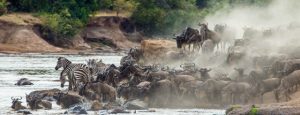
The endless plains of the Serengeti are the setting of one of the most impressive wildlife shows on earth: the great migration. Offering spectacular views while millions of wildebeest, zebra and gazelle thundering their way across the plains in an annual cycle of life and death between Tanzania and Kenya. The migration can be seen anytime of the year since the animals are always there. The most important is to know where the herds are at different times of the year. What is the best time for you to see the migration in the Serengeti?
January – March
After the short rains in November, December the plains in the Southern Serengeti are covered with fresh green grass. About 2 million wildebeest are here together with almost 200,000 zebras. After a month of eating nutrient-rich grass the female wildebeest prepare to give birth on the southern Serengeti plains. Between late January and March, half a million calves are born. An amazing spectacle, but heart-breaking at the same time as predators line up for an easy prey. This is also the place to be for bird lovers since many birds migrate from Europe to East Africa.
April
After months of feasting, the enormous herds thundering their way across the plains from the south, through the Moru Kopjes in the central Serengeti all the way to the Western Serengeti.
May- June
Head for the central and western Serengeti - the herds are there and getting ready for the toughest part of their journey. May and June is also a time of year when the mating season starts. You can see male wildebeest sparing and fighting to win the affection of the females. The wildebeest and zebra tend to grow into a mega-herd before crossing the Grumeti River, full of crocodiles, to continue north.
July - August
The survivors continue to the northern Serengeti. The waters of the Grumeti may be behind them, but a worse challenge is in store – the Mara River. Depending on rainfall, the annual crossings of the Mara River can begin as early as June or as late as August. The wildebeest and zebras must survive the Nile crocodiles and fast flowing water before facing the lions waiting on the other side. This time of the year game viewing is sensational, impressive and dramatic.
September
After the drama of the river crossings, herds break up into smaller groups. Part of the group remains in the northern Serengeti while others will make their way to Kenya’s Masai Mara. On the lookout for fresh grass the herds will walk all over the place, crossing and re-crossing the dreaded river and facing predators wherever they turn.
October - November
Most of the herds will begin making their way back south through the Serengeti in their search for juicy new grasses, as the rains begin to fall. They must reach the southern plains as soon as the first grasses begin to sprout. To watch the wildebeest, head to the eastern side of the Serengeti and the central Seronera region.
December
Feasting begins. The majority of the herds have reached the southern Serengeti plains by December and are rewarded with fresh juicy grasses. Calving begins, the predators move in and the cycle of life begins all over again. For them, every year is an endless journey, chasing the rains in a race for life.
Check the Serengeti Migration Safari itinerary

